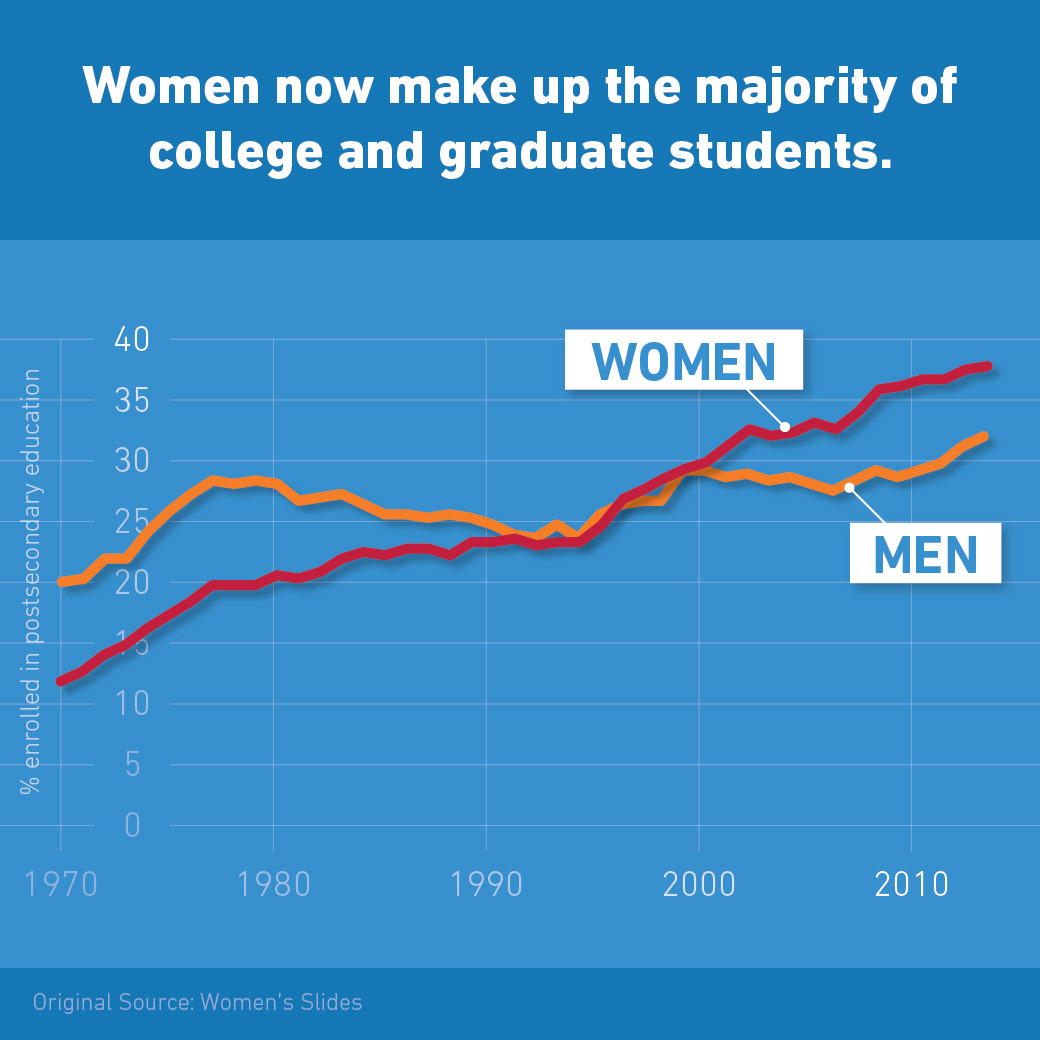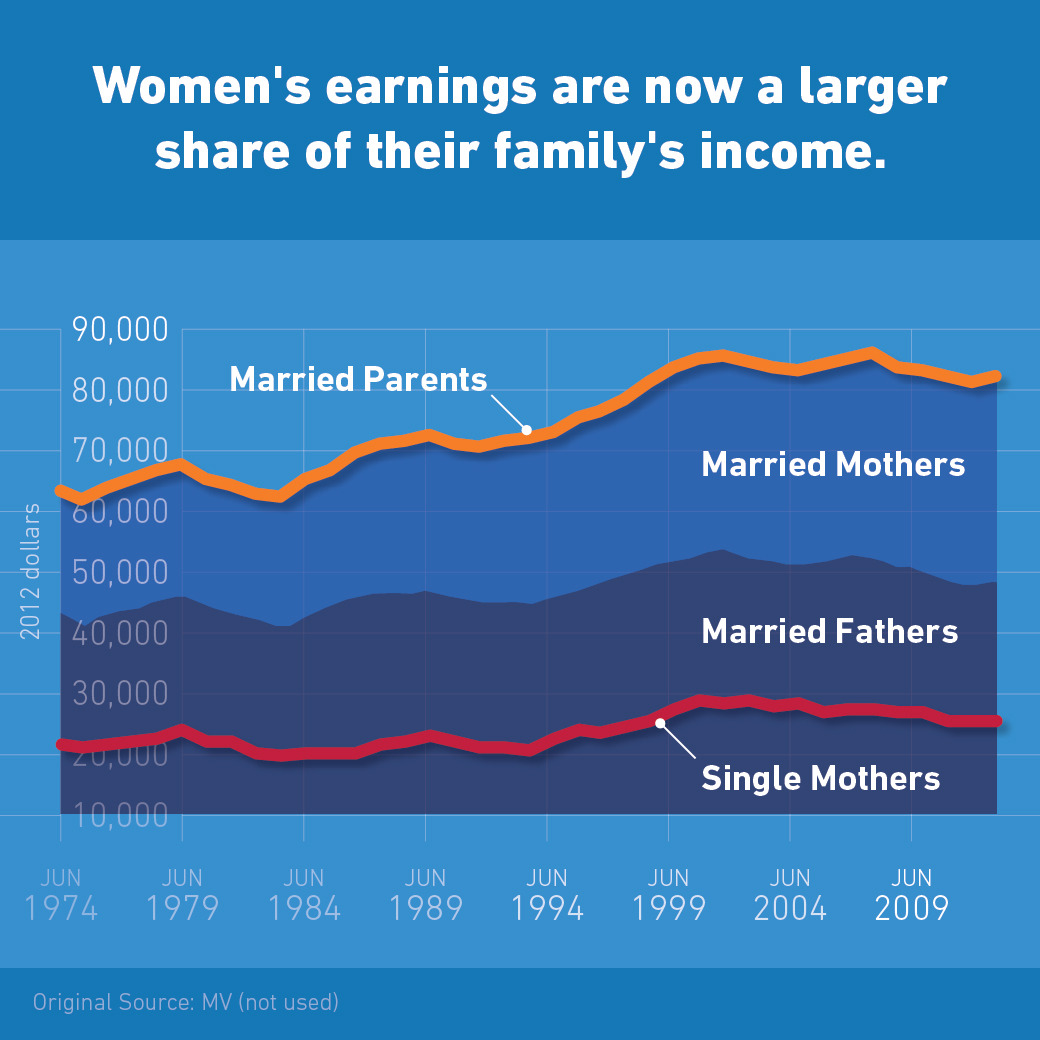
Today, White House Economist Betsey Stevenson is taking over the popular "I Love Charts" Tumblr blog in honor of Women's Equality Day. Follow along here, or on the White House Tumblr.
Hey everyone! Betsey Stevenson here from President Obama’s Council of Economic Advisers. In honor of Women’s Equality Day, I’ll be taking over I Love Charts to tell the story of the progress we’ve made in closing the earnings gap between women and men, and the challenges women still face in the workforce.
Let’s get started. Our first chart shows how women are increasingly contributing to family income and now make up about half the workforce. Since 2000, women’s labor force participation has dropped slightly, but most of that is because of cyclical factors and an aging population. While older women participate in the workforce at lower rates than younger women, the percent of older women who are working has increased since the mid-1990s, partially offsetting the overall decline.
At the other end of the spectrum, young women are more likely to be enrolled in school than they were a generation ago, and that’s good news. Since students (even ones who work part-time) are not considered to be in the labor force, increased school enrollment will depress the participation rate.
Wanna wonk out some more on this stuff? Check out our report on “Women’s Participation in Education and the Workforce.”

Next up, let’s talk about college: Women now make up the majority of college and graduate students. Nice work!
Since the mid-1990s:
- A greater share of young women have obtained four-year college degrees than men.
- The share of young women enrolled in both undergraduate and graduate study has increased.
- Most 18 to 34 year-old students are enrolled in undergraduate programs, and the percent enrolled in graduate school has gone way up.
Today, the share of young women enrolled in graduate school is more than 25% higher than the share of men. Learn more about how President Obama’s fighting to make college more affordable for women (and men).

Women have been doing some serious glass-ceiling cracking since the 1960’s. Young women are increasingly working in fields traditionally dominated by men.
Today, female college graduates ages 30 to 34 are just as likely to be employed as doctors, dentists, lawyers, professors, managers and scientists as they are to be employed as teachers, nurses, librarians, secretaries or social workers.
This is a big deal, and reflects the closing of a substantial gap. Women in the 1960’s were 7 times more likely to work in traditionally female occupations. Studies estimate that 15% to 20% of wage growth in the last 50 years was due to a decline in barriers to occupational choice.
So we’ve made a lot of progress, but clearly there’s more work to be done to get more women into predominately male-dominated fields and more men into female-dominated fields. For example, less than 20% of graduates in computer science and engineering are women, down from 37% in 1985. Reducing barriers to female occupational choice, including gender discrimination, would not only raise women’s earnings, but would also increase overall productivity by better matching workers’ skills to jobs.

Ok, let’s get back to wages.
The earnings gap between men and women still exists today, but since the 1970’s:
Women’s hourly earnings have grown more quickly than men’s, following a similar trend to GDP growth. Growth in median family income has largely come from increases in women’s earnings, rather than from men’s earnings. Earnings for both married and single mothers increased by about 33%. Married mothers’ contributions to total family income increased from less than one-third to about 40%. In other words, women are bringing home more of the bacon, but we still have more work to do to ensure equal pay for equal work.


Ok, so things are improving on many fronts when it comes to women in the workforce, but we’re slipping compared to other countries when it comes to female labor force participation.
Since 1990, the U.S. has dropped from 7th to 16th in that category among advanced democracies—that’s in the bottom third. In fact, we’re the only developed country that does not guarantee paid maternity leave.
But with the right policy changes, we can jump back up the leaderboard and help expand opportunity for millions of women. Paid leave and other policies that enable workers to better balance work and family obligations could help boost female labor force participation. One study estimated that U.S. female labor force participation would be 6.8 percentage points higher if the U.S. had implemented a suite of family-friendly policies. (cc Republicans in Congress)

Here's the bottom line: We're making progress, but the gender pay gap still exists at all income levels, and widens as people get older.
Highly-educated women with professional degrees tend to begin their careers at approximately the same salary level as their male counterparts, but as their careers progress, a gender gap opens up. By their late 30's, men with professional degrees earn 50% more than their female counterparts.
So how do we fix that? Beginning with the first bill he signed into law, President Obama's been fighting to help women receive the pay they deserve. But he can't do it all by himself. Congress needs to act to help ensure equal pay for women.
That's all for today! I hope you enjoy our charts. I had a blast. -- Betsey



